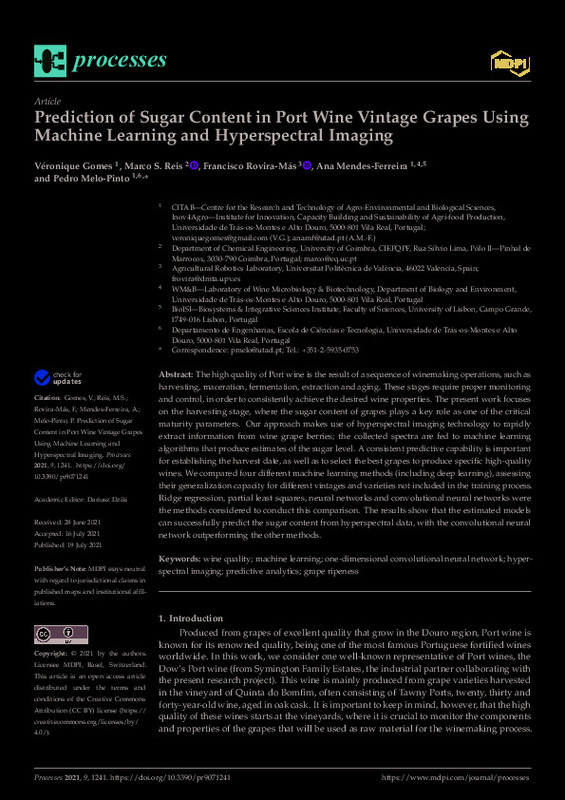JavaScript is disabled for your browser. Some features of this site may not work without it.
Buscar en RiuNet
Listar
Mi cuenta
Estadísticas
Ayuda RiuNet
Admin. UPV
Prediction of Sugar Content in Port Wine Vintage Grapes Using Machine Learning and Hyperspectral Imaging
Mostrar el registro sencillo del ítem
Ficheros en el ítem
| dc.contributor.author | Gomes, Veronique
|
es_ES |
| dc.contributor.author | Reis, Marco S.
|
es_ES |
| dc.contributor.author | Rovira Más, Francisco
|
es_ES |
| dc.contributor.author | Mendes-Ferreira, Ana
|
es_ES |
| dc.contributor.author | Melo-Pinto, Pedro
|
es_ES |
| dc.date.accessioned | 2023-04-18T18:00:39Z | |
| dc.date.available | 2023-04-18T18:00:39Z | |
| dc.date.issued | 2021-07 | es_ES |
| dc.identifier.uri | http://hdl.handle.net/10251/192818 | |
| dc.description.abstract | [EN] The high quality of Port wine is the result of a sequence of winemaking operations, such as harvesting, maceration, fermentation, extraction and aging. These stages require proper monitoring and control, in order to consistently achieve the desired wine properties. The present work focuses on the harvesting stage, where the sugar content of grapes plays a key role as one of the critical maturity parameters. Our approach makes use of hyperspectral imaging technology to rapidly extract information from wine grape berries; the collected spectra are fed to machine learning algorithms that produce estimates of the sugar level. A consistent predictive capability is important for establishing the harvest date, as well as to select the best grapes to produce specific high-quality wines. We compared four different machine learning methods (including deep learning), assessing their generalization capacity for different vintages and varieties not included in the training process. Ridge regression, partial least squares, neural networks and convolutional neural networks were the methods considered to conduct this comparison. The results show that the estimated models can successfully predict the sugar content from hyperspectral data, with the convolutional neural network outperforming the other methods. | es_ES |
| dc.description.sponsorship | This research was funded by Portuguese-FCT (PD/BD/128272/2017), under the Agrichains Doctoral Programme (PD/00122/2012). | es_ES |
| dc.language | Inglés | es_ES |
| dc.publisher | MDPI AG | es_ES |
| dc.relation.ispartof | Processes | es_ES |
| dc.rights | Reconocimiento (by) | es_ES |
| dc.subject | Wine quality | es_ES |
| dc.subject | Machine learning | es_ES |
| dc.subject | One-dimensional convolutional neural network | es_ES |
| dc.subject | Hyperspectral imaging | es_ES |
| dc.subject | Predictive analytics | es_ES |
| dc.subject | Grape ripeness | es_ES |
| dc.subject.classification | INGENIERIA AGROFORESTAL | es_ES |
| dc.title | Prediction of Sugar Content in Port Wine Vintage Grapes Using Machine Learning and Hyperspectral Imaging | es_ES |
| dc.type | Artículo | es_ES |
| dc.identifier.doi | 10.3390/pr9071241 | es_ES |
| dc.relation.projectID | info:eu-repo/grantAgreement/FCT/Investigador FCT/IF%2F00122%2F2012%2FCP0171%2FCT0001/PT | es_ES |
| dc.relation.projectID | info:eu-repo/grantAgreement/FCT/POR_NORTE/PD%2FBD%2F128272%2F2017/PT | es_ES |
| dc.rights.accessRights | Abierto | es_ES |
| dc.contributor.affiliation | Universitat Politècnica de València. Escuela Técnica Superior de Ingeniería Agronómica y del Medio Natural - Escola Tècnica Superior d'Enginyeria Agronòmica i del Medi Natural | es_ES |
| dc.description.bibliographicCitation | Gomes, V.; Reis, MS.; Rovira Más, F.; Mendes-Ferreira, A.; Melo-Pinto, P. (2021). Prediction of Sugar Content in Port Wine Vintage Grapes Using Machine Learning and Hyperspectral Imaging. Processes. 9(7):1-16. https://doi.org/10.3390/pr9071241 | es_ES |
| dc.description.accrualMethod | S | es_ES |
| dc.relation.publisherversion | https://doi.org/10.3390/pr9071241 | es_ES |
| dc.description.upvformatpinicio | 1 | es_ES |
| dc.description.upvformatpfin | 16 | es_ES |
| dc.type.version | info:eu-repo/semantics/publishedVersion | es_ES |
| dc.description.volume | 9 | es_ES |
| dc.description.issue | 7 | es_ES |
| dc.identifier.eissn | 2227-9717 | es_ES |
| dc.relation.pasarela | S\443878 | es_ES |
| dc.contributor.funder | Fundação para a Ciência e a Tecnologia, Portugal | es_ES |








